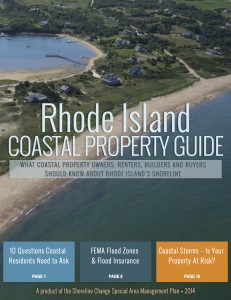CRC partnered with the Rhode Island Coastal Resources Management Council (CRMC) and Rhode Island Sea Grant to produce a guide for the state’s homeowners and businesses who own coastal property. The guide provides owners with steps they can take to protect their property from storm flooding and shoreline erosion.
“Rhode Island Coastal Property Guide: What Coastal Property Owners, Renters, Builders and Buyers Should Know About Rhode Island’s Shoreline” is available online or can be ordered as a hard-copy booklet (email: beachsamp@etal.uri.edu). The guide includes checklists and information to help readers determine their risks for flooding and erosion and to learn practical ways to protect their property.
“Rising sea level and extreme weather events resulting from global warming will have a significant impact on Rhode Island in the years to come,” said URI Graduate School of Oceanography Dean Bruce Corliss. “The Rhode Island Property Guide will provide timely and valuable information for residents and businesses to address these threats.”
The 30-page guide contains information about the unique circumstances – natural and regulatory – that affect property in the coastal zone. The information is provided in 10 sections and covers a range of areas from setbacks to septic systems.
Rhode Island Sea Grant Director Dennis Nixon said the guide is an example for coastal communities throughout the United States addressing the same challenges. “We’ve brought the best science in to inform this guidance, which is certainly applicable to shoreline communities in many states,” he said.
The guide was produced as part of the Rhode Island Shoreline Change Special Area Management Plan (Beach SAMP), a state effort developing comprehensive and practical regulatory guidance for coastal adaptation to flooding, storm surge, erosion and sea level rise. CRMC, CRC, Sea Grant and the Rhode Island Department of Environmental Management’s Bays, Rivers, and Watersheds Coordination Team funded the guide project.



